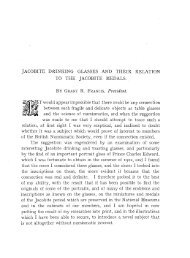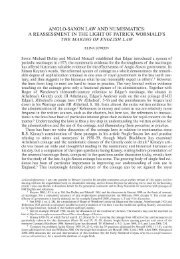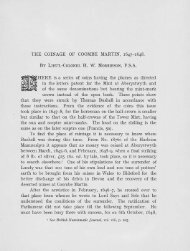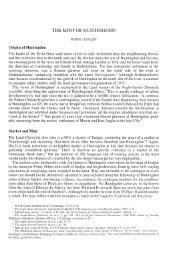the hiberno-norse coins in gotlands fornsal, visby - British ...
the hiberno-norse coins in gotlands fornsal, visby - British ...
the hiberno-norse coins in gotlands fornsal, visby - British ...
You also want an ePaper? Increase the reach of your titles
YUMPU automatically turns print PDFs into web optimized ePapers that Google loves.
THE HIBERNO-NORSE COINS IN<br />
GOTLANDS FORNSAL, VISBY<br />
MICHAEL DOLLEY<br />
IN active preparation is a fascicle of <strong>the</strong> <strong>British</strong> Academy's Sylloge of Co<strong>in</strong>s of <strong>the</strong><br />
<strong>British</strong> Isles where<strong>in</strong> will be illustrated approach<strong>in</strong>g 500 Hiberno-Norse pennies <strong>in</strong> <strong>the</strong><br />
Royal Co<strong>in</strong> Cab<strong>in</strong>et (KMK) at Stockholm. More than 400 of <strong>the</strong>se were struck<br />
dur<strong>in</strong>g <strong>the</strong> first two decades or so of <strong>the</strong> eleventh century, and <strong>the</strong>ir neglect by Irish<br />
students over <strong>the</strong> past century and more can only, be termed deplorable. The great<br />
majority of <strong>the</strong> Stockholm <strong>co<strong>in</strong>s</strong> derive from discoveries of quite literally tens of<br />
thousands of Vik<strong>in</strong>g-age <strong>co<strong>in</strong>s</strong> that have been made on Gotland, an island that<br />
geographically could be thought to occupy much <strong>the</strong> same position <strong>in</strong> <strong>the</strong> Baltic as<br />
Man <strong>in</strong> <strong>the</strong> Irish Sea. Dur<strong>in</strong>g two visits to Scand<strong>in</strong>avia <strong>in</strong> <strong>the</strong> late summer of 1976 <strong>the</strong><br />
writer came to <strong>the</strong> conclusion that <strong>the</strong> time was probably ripe for an <strong>in</strong>vestigation of<br />
<strong>the</strong> Irish material actually preserved <strong>in</strong> <strong>the</strong> really quite magnificent museum at Visby<br />
known as Gotlands Fornsal (GF). Founded by local <strong>in</strong>itiatives a century or so ago,<br />
this <strong>in</strong>stitution is a sh<strong>in</strong><strong>in</strong>g example of what can be achieved when public money at<br />
<strong>the</strong> national level is used judiciously to supplement <strong>in</strong>sular resources and, above all,<br />
enthusiasms.<br />
Disappo<strong>in</strong>t<strong>in</strong>gly few locally found <strong>co<strong>in</strong>s</strong> <strong>in</strong> fact are on exhibition at GF, official<br />
policy at government level be<strong>in</strong>g to send over on long-term loan from Stockholm<br />
a very limited number of <strong>the</strong> hoards which, under <strong>the</strong> Swedish law of treasure trove,<br />
all go <strong>in</strong> <strong>the</strong> first place to KMK. At present, too, even this number is artificially low<br />
because of <strong>the</strong> legitimate requirements of cont<strong>in</strong>u<strong>in</strong>g work on <strong>the</strong> Corpus Nummorum<br />
saeculorum IX-XI qui <strong>in</strong> Suecia reperti sunt of which <strong>the</strong> first fascicle (edd. B. Maimer<br />
and fN. L. Rasmusson) appeared <strong>in</strong> 1975, <strong>the</strong> second <strong>in</strong> 1977. Published already by<br />
<strong>the</strong> present writer <strong>in</strong> <strong>the</strong> 1957 number of Gotlandskt Arkiv (p. 50) were <strong>the</strong> two<br />
Hiberno-Norse pennies <strong>in</strong> <strong>the</strong> 1952 hoard from Gandarve <strong>in</strong> Alva parish (GF 9851;<br />
G. Hatz, Handel und Verkehr zwischen dem Deutschen Reich und Schweden <strong>in</strong> der<br />
spciten Wik<strong>in</strong>gerzeit (Stockholm, 1974), no. 263), and vol. 98 (1968) of <strong>the</strong> Journal of<br />
<strong>the</strong> Royal Society of Antiquaries of Ireland (pp. 57-62) lists <strong>in</strong> a paper from <strong>the</strong> same<br />
pen <strong>the</strong> fifteen (recte fourteen?) Dubl<strong>in</strong> <strong>co<strong>in</strong>s</strong> from <strong>the</strong> 1966 discovery at Karls <strong>in</strong><br />
T<strong>in</strong>gstade parish (GF 10396; Hatz 232), while on pp. 197-9 of <strong>the</strong> same volume <strong>the</strong>re<br />
are described <strong>the</strong> three (recte two) Hiberno-Norse pennies from <strong>the</strong> enormous Burge<br />
treasure of 1967 from Lummelunda parish (SHM Inv. 28830; Hatz 375), though this<br />
hoard has yet to be returned to <strong>the</strong> island. Interest<strong>in</strong>gly, no Dubl<strong>in</strong> co<strong>in</strong> appears to<br />
have been present <strong>in</strong> <strong>the</strong> most recent of all <strong>the</strong> Gotland hoards of <strong>the</strong> eleventh<br />
century, <strong>the</strong> discovery of 130 Vik<strong>in</strong>g-Age silver <strong>co<strong>in</strong>s</strong> at Liffride <strong>in</strong> Larbo parish duly<br />
noted by <strong>the</strong> excavator, Miss Anna-Lena Gerd<strong>in</strong>, on p. 116 of <strong>the</strong> 1974 volume of<br />
Gotlandskt Arkiv. On <strong>the</strong> face of it, this hoard was concealed as late as <strong>the</strong> 1020s, <strong>in</strong><br />
which case <strong>the</strong>re should have been plenty of time for Hiberno-Norse <strong>co<strong>in</strong>s</strong> to have
HIBERNO-NORSE COINS IN GOTLANDS FORNSAL, VISBY 21<br />
found <strong>the</strong>ir way <strong>in</strong>to it, but an exam<strong>in</strong>ation of <strong>the</strong> actual <strong>co<strong>in</strong>s</strong> made possible by <strong>the</strong><br />
personal k<strong>in</strong>dness of amanuens Ragnar Engestrom of <strong>the</strong> National Antiquities<br />
Service's special Gotland Excavations Unit (RAGU) revealed that it is essentially<br />
a hoard of Digerakra type (SHM Inv. 18744; Hatz 104), with <strong>the</strong> <strong>in</strong>sular element<br />
exhibit<strong>in</strong>g an abrupt 'cut-off' c. 998, to which <strong>the</strong>re was added at <strong>the</strong> time of<br />
concealment a handful only of later pieces. Recent work has suggested that <strong>the</strong><br />
Hiberno-Norse co<strong>in</strong>age did not beg<strong>in</strong> to be struck before <strong>the</strong> summer of 997, and it<br />
was quite literally only at <strong>the</strong> very end of <strong>the</strong> tenth century that Dubl<strong>in</strong> <strong>co<strong>in</strong>s</strong> began to<br />
reach Scand<strong>in</strong>avia <strong>in</strong> any quantity. We may disregard, <strong>the</strong>n, any possibility that <strong>the</strong><br />
major discovery of perhaps as many as 1,750 <strong>co<strong>in</strong>s</strong> made c. 1973 at limestone<br />
work<strong>in</strong>gs at Smiss <strong>in</strong> T<strong>in</strong>gstade parish <strong>in</strong>cluded Hiberno-Norse pieces. Several<br />
hundred <strong>co<strong>in</strong>s</strong> only from o<strong>the</strong>r series have been recovered to form <strong>the</strong> basis of a<br />
successful prosecution of <strong>the</strong> f<strong>in</strong>ders for non-disclosure, and <strong>the</strong>se suggest that<br />
concealment took place no later than c. 999—<strong>in</strong>formation from Mr. Kenneth<br />
Jonsson of Stockholm who publishes <strong>the</strong> parcel <strong>in</strong> a forthcom<strong>in</strong>g number of<br />
Numismatisk Arsskrift. For <strong>the</strong> sake of completeness, too, mention should perhaps be<br />
made of <strong>the</strong> July 1972 f<strong>in</strong>d at Burge <strong>in</strong> Lummelunda parish (SHM Inv. 29559-62;<br />
Hatz, p. 232) noticed by <strong>the</strong> present writer on p. 450 of <strong>the</strong> 1972 Numismatic Circular<br />
(cf. Gotlandskt Arkiv, 1972, p. 111). The hoard appears to have been concealed at<br />
about <strong>the</strong> same time as <strong>the</strong> slightly larger f<strong>in</strong>d from Liffride, but with fewer than 100<br />
<strong>co<strong>in</strong>s</strong> present <strong>the</strong> absence of Hiberno-Norse <strong>co<strong>in</strong>s</strong> could well be fortuitous.<br />
From <strong>the</strong> forego<strong>in</strong>g citation of <strong>the</strong> more recent f<strong>in</strong>ds it should be clear that over <strong>the</strong><br />
last two centuries <strong>the</strong> soil of Gotland has given up Dubl<strong>in</strong> pennies of Sihtric<br />
Silkbeard quite literally by <strong>the</strong> hundred, and it must be borne <strong>in</strong> m<strong>in</strong>d that over <strong>the</strong><br />
last few decades <strong>the</strong> <strong>in</strong>cidence of discovery of hoards seems to have fallen sharply as<br />
aga<strong>in</strong>st earlier experience. Sad to say, <strong>the</strong> Dubl<strong>in</strong> series today is represented <strong>in</strong> <strong>the</strong><br />
systematic collections of GF by no more than <strong>the</strong> odd specimen! Essentially, <strong>the</strong><br />
Visby cab<strong>in</strong>et derives from <strong>the</strong> collections f<strong>in</strong>ally made over to it <strong>in</strong> <strong>the</strong> early part of<br />
this century by <strong>the</strong> old Grammar School of <strong>the</strong> city which <strong>in</strong> due course became<br />
known as Visby Elementarldroverk (VE). On <strong>the</strong> early history of <strong>the</strong> numismatic<br />
portion of <strong>the</strong>se collections we are <strong>in</strong>deed fortunate enough to possess a remarkably<br />
detailed study from <strong>the</strong> pen of one of <strong>the</strong> more competent of Gotland's amateur<br />
antiquaries, Richard Steffen (1862-1948), who after his 1928 retirement from <strong>the</strong><br />
headmastership devoted <strong>the</strong> rest of his life to <strong>the</strong> herculean task of br<strong>in</strong>g<strong>in</strong>g <strong>in</strong>to order<br />
<strong>the</strong> island's archives, work recognized by <strong>the</strong> State two years before his death with <strong>the</strong><br />
grant of <strong>the</strong> title of Professor (cf. Gotlandskt Arkiv, 1948-9, pp. 7-12, and for a list of<br />
his earlier writ<strong>in</strong>gs ibid. 1942, pp. 213-22). This history of <strong>the</strong> VE cab<strong>in</strong>et was<br />
published <strong>in</strong> 1928 <strong>in</strong> a limited edition (100 copies) as a separately pag<strong>in</strong>ated (1-38)<br />
supplement to <strong>the</strong> school's annual report (R. Steffen, 'Anteckn<strong>in</strong>gar om Visby hogre<br />
allmanna laroverks Mynt- och antikvitetssaml<strong>in</strong>g', Hogre Allmanna Ldroverkets i<br />
Visby Arsredogdrelsen, 1928). From it we learn of a manuscript fair copy catalogue,<br />
unfortunately <strong>in</strong>complete, dat<strong>in</strong>g from <strong>the</strong> early 1840s and entitled Inregistrer<strong>in</strong>gsbok<br />
for Wisby Gymnasii Mynt, Medaljer och Antiquiteter. Kept now <strong>in</strong> GF, it suggests<br />
that <strong>the</strong> orig<strong>in</strong>al collections were relatively richer <strong>the</strong>n than at <strong>the</strong> time of <strong>the</strong>ir<br />
transfer. Listed by <strong>the</strong> honorary curator, <strong>the</strong> Revd. Dr. Johan Enequist (1787-1856),<br />
a member of <strong>the</strong> staff s<strong>in</strong>ce 1821, are some 200 <strong>co<strong>in</strong>s</strong>, ma<strong>in</strong>ly classical, oriental,
22 HIBERNO-NORSE COINS IN GOTLANDS FORNSAL, VISBY 22<br />
Anglo-Saxon, and medieval German, which were acquired between 1836 and <strong>the</strong> end<br />
of 1841. Nearly a third, 66 to be precise, purport to be English, and on this tell<strong>in</strong>g <strong>the</strong><br />
tally of Hiberno-Norse <strong>co<strong>in</strong>s</strong> (four—recte five) is somewhat higher than <strong>the</strong> normal<br />
proportion of Dubl<strong>in</strong> <strong>co<strong>in</strong>s</strong> to English <strong>in</strong> Scand<strong>in</strong>avian hoards of <strong>the</strong> period might<br />
have led one to suspect.<br />
An analysis of <strong>the</strong> 1841 hold<strong>in</strong>gs of Anglo-Saxon <strong>co<strong>in</strong>s</strong> is not without <strong>in</strong>terest even<br />
to <strong>the</strong> Irish student, and makes it clear (a) that probably not all <strong>the</strong> <strong>co<strong>in</strong>s</strong> <strong>the</strong>n <strong>in</strong> <strong>the</strong><br />
VE cab<strong>in</strong>et were registered before <strong>the</strong> catalogue's discont<strong>in</strong>uance, and (b) that those<br />
listed are likely to have derived from a number of parcels from different f<strong>in</strong>ds and not<br />
all from one particular, let alone identifiable, hoard. A list<strong>in</strong>g by reigns, types, m<strong>in</strong>ts,<br />
and moneyers follows, and added (a) is <strong>the</strong> orig<strong>in</strong>al catalogue number, (b) a letter to<br />
<strong>in</strong>dicate <strong>the</strong> date when <strong>the</strong> entry was made, and (c) a + to <strong>in</strong>dicate that a comparable<br />
piece still is to be found <strong>in</strong> <strong>the</strong> systematic collections of GF. The apparent total<br />
absence of Crux <strong>co<strong>in</strong>s</strong> of iE<strong>the</strong>lrad II <strong>in</strong> itself should sufficiently <strong>in</strong>dicate <strong>the</strong><br />
artificiality of <strong>the</strong> orig<strong>in</strong>al selection, but even so <strong>the</strong> fur<strong>the</strong>r details are given <strong>in</strong> case a<br />
new generation of students one day may be able to marry up some of <strong>the</strong> more<br />
remarkable pieces with <strong>in</strong>dividual Gotland hoards from <strong>the</strong> critical qu<strong>in</strong>quennium—<br />
Bror Emil Hildebrand records (Anglosachsiska mynt, 1st edn. (Stockholm, 1846),<br />
pp. liii-lxi) no fewer than eight significant hoards discovered on <strong>the</strong> island between<br />
1836 and 1841.<br />
The follow<strong>in</strong>g is <strong>the</strong> alphabetical key to <strong>the</strong> dates of actual registration:<br />
A 12 July 1836 D 5 July 1839<br />
B 6 August 1837 E 3 August 1839<br />
C 3 June 1839 F 20 December 1841<br />
and <strong>the</strong> list<strong>in</strong>g runs:<br />
First Hand<br />
1. Chester, 'Leofstan' (recte<br />
Leomman?)<br />
2. London, 'Algar'<br />
3. „ Godw<strong>in</strong>e<br />
4. ,, Leofstan (?Second<br />
Hand)<br />
5. York, Alfstan (under Second<br />
Hand!)<br />
Second Hand<br />
6. W<strong>in</strong>chester (??), 'Andgrim'<br />
7. „<br />
Hand)<br />
Regenulf (? First<br />
Long Cross<br />
8. L<strong>in</strong>coln, jE<strong>the</strong>lnoth<br />
9. Shaftesbury, Goda<br />
14 A<br />
89 C +<br />
90 C<br />
91 C ?<br />
132 E<br />
133 E<br />
134 E<br />
128 E +<br />
129 E +<br />
II<br />
Helmet<br />
10. Cambridge, Cnit 183 F<br />
11. Hereford, .idew<strong>in</strong>e 181 F<br />
12. Hunt<strong>in</strong>gdon, jE<strong>the</strong>lstan 131 E +<br />
13. London, Eadmund 184 F<br />
14. York, Arnthur 182 F +<br />
Last Small Cross<br />
15. Cricklade, ^Elw<strong>in</strong>e 170 F +<br />
16. Exeter, Carla 172 F +<br />
17. Idem 173 F<br />
18. Lewes, ^Elfwerd 169 F +<br />
19. Norwich, Eadwacer 175 F +<br />
20. Shaftesbury, ^Elfw<strong>in</strong>e 176 F +<br />
21. Stamford, ^.<strong>the</strong>lwold 168 F<br />
22. „ Godw<strong>in</strong>e 177 F +<br />
23. Idem 178 F +<br />
24. Thetford, Wslgisth {var.<br />
Hild. A.c.) 180 F<br />
25. W<strong>in</strong>chester, Alfwold 171 F<br />
26. „ Siboda 130 E +<br />
27. York, Thorolf 179 F
HIBERNO-NORSE COINS IN GOTLANDS FORNSAL, VISBY 23<br />
CNUT<br />
Quatrefoil Po<strong>in</strong>ted Helmet<br />
28. Cambridge, Ade 85 C 45. Chester, Leofwig 187 F<br />
29. „ Leofsig 201 F + 46. L<strong>in</strong>coln, Leodmsr 189 F<br />
30. „ Wulfsige 205 F + 47. ,, Leofwii 186 F<br />
31. Dover, Leofw<strong>in</strong>e 200 F 48. „ Oslac 192 F +<br />
32. Hertford, Lif<strong>in</strong>c 88 C 49. London, Leofstan 83 C<br />
33. „ Wulfric 204 F + 50. ,, Leofwold 84 C<br />
34. London, ^Elfwold 206 F 51. ,, Wynstan 193 F<br />
35. ,, Elew<strong>in</strong>e 87 C + 52. Idem 194 F<br />
36. Lydford, Godric 198 F + 53. Idem 195 F<br />
37. Shaftesbury, yElric 197 F 54. Stamford, Leofwold 188 F +<br />
38. Shrewsbury, Grim 199 F + 55. Morolf 190 F<br />
39. Wall<strong>in</strong>gford, Eadw<strong>in</strong>e 196 F 56. Morulf 191 F +<br />
40. W<strong>in</strong>chester, Godw<strong>in</strong>e 208 F + 57. W<strong>in</strong>chester, Godw<strong>in</strong>e 185 F +<br />
41. York, Asgutr 86 C + 58. York, Hildolf 82 C +<br />
42.<br />
43.<br />
44. ,,<br />
,,<br />
,, Colgrim<br />
Fer<strong>the</strong><strong>in</strong><br />
Outhgrim<br />
202<br />
207<br />
203<br />
F<br />
F<br />
F +<br />
Short<br />
59. London, Goman<br />
60. „ Leofwig<br />
Cross<br />
209<br />
210<br />
F<br />
F<br />
61. Stamford, Leofw<strong>in</strong>e 211 F<br />
62. York, Rtefen<br />
212 F<br />
EDWARD THE CONFESSOR<br />
Radiate Small Cross Smalt Flan<br />
63. L<strong>in</strong>coln, 'Hotsian' 17 B 65. L<strong>in</strong>coln, Godw<strong>in</strong>e 109 D<br />
64. Idem. A dittography? 110 D<br />
A sixty-sixth co<strong>in</strong> (no. 174 <strong>in</strong> <strong>the</strong> Inregistrer<strong>in</strong>gsbok—20 December 1841) proves to<br />
be Hiberno-Norse and is discussed below.<br />
Four o<strong>the</strong>r <strong>co<strong>in</strong>s</strong> registered on 20 December 1841 were rightly recognized as<br />
belong<strong>in</strong>g to <strong>the</strong> 'Irish' (Hiberno-Norse) series. All were described as of Long Cross<br />
type, and may be presumed <strong>in</strong> consequence to belong to Phase I (cf. M. Dolley, The<br />
Hiberno-Norse Co<strong>in</strong>s <strong>in</strong> <strong>the</strong> <strong>British</strong> Museum (London, 1966), pp. 119-27) with a date<br />
no later than <strong>the</strong> first decade of <strong>the</strong> eleventh century. Two (nos. 227 and 228 <strong>in</strong> <strong>the</strong><br />
Inregistrer<strong>in</strong>gsbok—20 December 1841) have <strong>the</strong> Dubl<strong>in</strong> m<strong>in</strong>t-signature <strong>in</strong> an<br />
unequivocal form, and so may be equated with a run of unprovenanced <strong>co<strong>in</strong>s</strong> <strong>in</strong><br />
KMK (e.g. B. E. Hildebrand, Anglosachsiska mynt, 2nd edn. (Stockholm, 1881),<br />
nos. 34-55 and 19 respectively). A third (no. 229 <strong>in</strong> <strong>the</strong> Inregistrer<strong>in</strong>gsbok—aga<strong>in</strong><br />
20 December 1841) and likewise <strong>in</strong> Sihtric's name purports to have been struck <strong>in</strong><br />
England by <strong>the</strong> Wilton moneyer Godw<strong>in</strong>e, and so may be presumed to be a dieduplicate<br />
of BEH Sihtric 98—and of a co<strong>in</strong> now also <strong>in</strong> KMK ex <strong>the</strong> 1900<br />
Mannegarda hoard from Lye parish on Gotland (SHM Inv. 11300; Hatz 359), if<br />
<strong>in</strong>deed it is not BEH Sihtric 98 itself. The fourth co<strong>in</strong> (no. 230 <strong>in</strong> <strong>the</strong> Inregistrer<strong>in</strong>gsbok—yet<br />
aga<strong>in</strong> 20 December 1841) appears to settle <strong>the</strong> matter quite conclusively. It<br />
is one of <strong>the</strong> rare pieces where <strong>the</strong> obverse legend beg<strong>in</strong>s not with Sihtric's name but<br />
+ DYMNROE+ , while <strong>the</strong> reverse with its particular degeneration of <strong>the</strong> Dubl<strong>in</strong><br />
m<strong>in</strong>t-signature rema<strong>in</strong>s to this day unique for <strong>the</strong> particular comb<strong>in</strong>ation. There<br />
seems little room for doubt, <strong>the</strong>n, that <strong>the</strong> co<strong>in</strong> is BEH Thymn 8, and <strong>in</strong> <strong>the</strong> most
HIBERNO-NORSE COINS IN GOTLANDS FORNSAL, VISBY 24<br />
satisfy<strong>in</strong>g manner <strong>the</strong> writer's friend Mr. Kenneth Jonsson of Stockholm has been<br />
able to turn up archival evidence <strong>in</strong> <strong>the</strong> Statens Historiska Museum that <strong>in</strong> 1879<br />
KMK acquired from VE four Hiberno-Norse <strong>co<strong>in</strong>s</strong> (SHM Inv. 6359) which can be<br />
shown to comprise BEH Sihtric 1, 90, and BEH Thymn 8. Admittedly BEH Sihtric 1<br />
and 90 do not conform to <strong>the</strong> Inregistrer<strong>in</strong>gsbok descriptions, but this is very<br />
plausibly expla<strong>in</strong>ed by <strong>the</strong> supposition of <strong>the</strong>ir acquisition by VE after 1841 and<br />
before 1879. As it happens, too, BEH 90 is ano<strong>the</strong>r great rarity <strong>in</strong> <strong>the</strong> Hiberno-Norse<br />
series, and <strong>the</strong> picture seems clear enough. In 1879 <strong>the</strong> age<strong>in</strong>g Bror Emil Hildebrand,<br />
revert<strong>in</strong>g to one of his first loves, was br<strong>in</strong>g<strong>in</strong>g toge<strong>the</strong>r material for <strong>the</strong> def<strong>in</strong>itive<br />
second edition (Stockholm, 1881) of his Anglosachsiska rnynt, and it is easy to<br />
imag<strong>in</strong>e how <strong>the</strong> venerable riksantikvarie and secretary of <strong>the</strong> Vitterhets akademie<br />
was able to use <strong>the</strong> weight of his authority to persuade a doubtless deferential schoolboard<br />
<strong>in</strong> Visby to make over, <strong>in</strong> <strong>the</strong> <strong>in</strong>terests of completeness, <strong>co<strong>in</strong>s</strong> lack<strong>in</strong>g <strong>in</strong> <strong>the</strong><br />
national collections—BEH Sihtric 1 is relatively common today only because of<br />
examples which have come to light s<strong>in</strong>ce 1881. This still leaves us, of course, with<br />
Inregistrer<strong>in</strong>gsbok nos. 227 and 228, but one suspects that <strong>the</strong> second, at least, was<br />
<strong>the</strong> subject of an earlier and perhaps less formal exchange with KMK—<strong>the</strong> unprovenanced<br />
BEH Sihtric 19 is ano<strong>the</strong>r hapax co<strong>in</strong> where <strong>the</strong> Stockholm cab<strong>in</strong>et is<br />
concerned, while a high proportion of <strong>the</strong> <strong>co<strong>in</strong>s</strong> listed as BEH Sihtric 34-55 still to<br />
this day cannot be duplicated.<br />
It is at this stage of <strong>the</strong> argument that account should perhaps be taken of <strong>the</strong> sixtysixth<br />
of <strong>the</strong> <strong>co<strong>in</strong>s</strong> reckoned as English by <strong>the</strong> 1841 cataloguer. The reverse legend was<br />
read by him (+)DLDORNOLVNDRIN, and it is described as of (Last) Small Cross type<br />
with, <strong>in</strong> <strong>the</strong>ory, some sort of approximation to ^E<strong>the</strong>lrad II's name and style. Noth<strong>in</strong>g<br />
comparable is <strong>in</strong> <strong>the</strong> Visby cab<strong>in</strong>et today, but one suspects a duplicate of BEH Sihtric<br />
83 var. <strong>in</strong> KMK which has <strong>the</strong> reverse legend +DGDOANOLVNDRIH, if it is not <strong>in</strong>deed<br />
<strong>the</strong> actual co<strong>in</strong>. The apparently too discrepant obverse legend of <strong>the</strong> Stockholm co<strong>in</strong><br />
could be thought to militate aga<strong>in</strong>st this, but frankly <strong>the</strong> competence of Dr. Enequist,<br />
as evidenced <strong>in</strong> <strong>the</strong> pages of <strong>the</strong> Inregistrer<strong>in</strong>gsbok, more than once leaves someth<strong>in</strong>g<br />
to be desired. In fairness to his memory, never<strong>the</strong>less, one must recall that he was<br />
list<strong>in</strong>g unfamiliar material at a period when <strong>the</strong> 1846 edition of Anglosachsiska mvnt<br />
had still to appear. Nor should it be forgotten that he was very much an honorary<br />
curator of <strong>the</strong> school collections, and without neglect<strong>in</strong>g his pedagogic and parochial<br />
charges he still found time to be a very f<strong>in</strong>e amateur musician—one of his daughters,<br />
<strong>in</strong>cidentally, became a professional s<strong>in</strong>ger under <strong>the</strong> name 'Biond<strong>in</strong>i', settled <strong>in</strong><br />
London as a music-teacher, and died <strong>the</strong>re <strong>in</strong> 1899 (cf. E. Nyberg, Gotlandsk<br />
Sldktbok, Ekenas (= Tammissaari), 1938, pp. 170 and 171). Regrettably, too, <strong>the</strong>re<br />
cannot be found today <strong>the</strong> rough draft of <strong>the</strong> Inregistrer<strong>in</strong>gsbok seen by Steffen <strong>in</strong> <strong>the</strong><br />
1920s and apparently <strong>in</strong>clud<strong>in</strong>g provenances omitted from <strong>the</strong> fair copy. Fur<strong>the</strong>r<br />
speculation is probably profitless, but what does seem certa<strong>in</strong> is that not one of <strong>the</strong><br />
five Hiberno-Norse pieces registered by Enequist <strong>in</strong> 1841 is <strong>in</strong> <strong>the</strong> Visby cab<strong>in</strong>et<br />
today. One hastens to add that <strong>the</strong> same holds good for perhaps half of <strong>the</strong> English<br />
<strong>co<strong>in</strong>s</strong> recorded <strong>in</strong> <strong>the</strong> Inregistrer<strong>in</strong>gsbok begun <strong>in</strong> 1836, but <strong>in</strong> <strong>the</strong> case of <strong>the</strong>se too<br />
<strong>the</strong>re is not <strong>the</strong> least reason to suspect malfeasance. Down <strong>the</strong> years <strong>the</strong>re has been a<br />
whole series of exchanges between VE and KMK, and <strong>the</strong> present strength of <strong>the</strong><br />
Anglo-Saxon portion of <strong>the</strong> GF cab<strong>in</strong>et (cf. Appendix) should make it clear that
HIBERNO-NORSE COINS IN GOTLANDS FORNSAL, VISBY 25<br />
overall no advantage had been taken of <strong>the</strong> <strong>in</strong>sular museum. It is just that <strong>the</strong><br />
Hiberno-Norse element happens to have borne <strong>the</strong> brunt of <strong>the</strong> sacrifices, and it is<br />
only fair to add that until quite recently it was <strong>the</strong> Anglo-Saxon series which was<br />
prized academically, with <strong>the</strong> Dubl<strong>in</strong> <strong>co<strong>in</strong>s</strong> very much <strong>the</strong> poor relations. What one<br />
does very much regret, on <strong>the</strong> o<strong>the</strong>r hand, is that <strong>in</strong> so many cases <strong>in</strong>dividual hoardprovenances,<br />
or vital clues to <strong>the</strong> same, must have been lost, though even here patient<br />
archival research is do<strong>in</strong>g much to redress <strong>the</strong> position. For example, <strong>in</strong> connection<br />
with <strong>the</strong> forthcom<strong>in</strong>g SCBI fascicle devoted to <strong>the</strong> KMK's unrivalled collection of<br />
<strong>co<strong>in</strong>s</strong> from <strong>the</strong> first part of <strong>the</strong> reign of Edward <strong>the</strong> Confessor, Mr. Kenneth Jonsson<br />
already has established VE provenances <strong>in</strong> respect of BEH Edw. Conf. 35, 51, 53, 61,<br />
74, 177, 310, 412, 450, 598, 609, and 746, and work of this k<strong>in</strong>d is only now beg<strong>in</strong>n<strong>in</strong>g.<br />
In <strong>the</strong> case of <strong>the</strong> present paper, all that now rema<strong>in</strong>s is to give details of <strong>the</strong> four<br />
Hiberno-Norse pennies <strong>in</strong> GF which have not been <strong>the</strong> subject of recent publication.<br />
Three (a, b, and d) are <strong>in</strong> <strong>the</strong> VE cab<strong>in</strong>et, and may be presumed to have been acquired<br />
by <strong>the</strong> school subsequently to 1841, and almost certa<strong>in</strong>ly before <strong>the</strong> beg<strong>in</strong>n<strong>in</strong>g of this<br />
century. The fourth (c) was <strong>the</strong> sole Hiberno-Norse penny <strong>in</strong> one of <strong>the</strong> hoards first to<br />
be returned on long-term loan from KMK to GF, <strong>the</strong> 1920 discovery made at<br />
Osterby <strong>in</strong> O<strong>the</strong>m parish (SHM Inv. 16450; GF C 1383; Hatz 160). Roughly 200<br />
<strong>co<strong>in</strong>s</strong> were <strong>in</strong>volved, and <strong>the</strong>re seems no record of any ornaments or of hacksilver<br />
accompany<strong>in</strong>g <strong>the</strong> specie, nor <strong>in</strong>deed of any conta<strong>in</strong>er. It seems, <strong>in</strong>deed, a hoard<br />
essentially of <strong>the</strong> same two-tier type as that from Liffride, though somewhat larger.<br />
Nearly a quarter of <strong>the</strong> <strong>co<strong>in</strong>s</strong> (?) are Kufic, <strong>the</strong> latest apparently struck c. 1003, 3 are<br />
Byzant<strong>in</strong>e miliaresia struck probably no later than <strong>the</strong> millennium, 39 German, of<br />
which 2 perhaps belong after 1024 though most of <strong>the</strong> o<strong>the</strong>rs are substantially earlier,<br />
1 Danish (c. 1015?), and 12 Scand<strong>in</strong>avian imitations (2 of <strong>the</strong>m on square flans). The<br />
pattern presented by <strong>the</strong> 82 Anglo-Saxon pieces is as follows:<br />
Second Hand 1 , . c ,, ~ ,,<br />
„ „„ Last Small Cross 21<br />
Crux 22 ^ , r •, ,<br />
, ~ Quatrefoil 3<br />
Long Cross 28 Po<strong>in</strong>ted Helmet 5<br />
Helmet 2<br />
so that <strong>the</strong> <strong>in</strong>sular element at least may surely be thought to have been brought to <strong>the</strong><br />
island no later than <strong>the</strong> third decade of <strong>the</strong> eleventh century.<br />
Earliest of <strong>the</strong> four Hiberno-Norse <strong>co<strong>in</strong>s</strong> is <strong>the</strong> unprovenanced penny of Sihtric<br />
Silkbeard's first co<strong>in</strong>age of Dubl<strong>in</strong> [Fig. 1]. The prototype is one of <strong>the</strong> so-called
26 HIBERNO-NORSE COINS IN GOTLANDS FORNSAL, VISBY<br />
Small Crux pennies of ^E<strong>the</strong>lrad II, and so <strong>the</strong> imitation is unlikely to belong earlier<br />
than <strong>the</strong> summer of 997 (cf. M. Dolley, 'The Forms of <strong>the</strong> Proper Names Appear<strong>in</strong>g<br />
on <strong>the</strong> Earliest Co<strong>in</strong>s struck <strong>in</strong> Ireland', <strong>in</strong> F. Sandgren, ed., Otium et Negotium,<br />
Stockholm, 1973, pp. 49-65). It is from <strong>the</strong> same dies as two pennies listed <strong>the</strong>re<br />
(p. 64, nos. 50« and 506) as <strong>in</strong> <strong>the</strong> National Museum of Ireland (ex c. 1830 Clondalk<strong>in</strong><br />
hoard) and <strong>the</strong> <strong>British</strong> Museum (ex R. C. Lockett sale). The weight is 1-47 g., and <strong>the</strong><br />
die-axis 110°. Both <strong>the</strong> obverse and <strong>the</strong> reverse legends are largely un<strong>in</strong>telligible, but<br />
<strong>the</strong> obverse die is also known from <strong>co<strong>in</strong>s</strong> with legends clearly <strong>in</strong>corporat<strong>in</strong>g <strong>the</strong> names<br />
of moneyers Fastulfr and Toki toge<strong>the</strong>r with unequivocal Dubl<strong>in</strong> m<strong>in</strong>t-signatures.<br />
Omitted from <strong>the</strong> 1973 list<strong>in</strong>g and only recognized as Hiberno-Norse <strong>in</strong> September<br />
1976 and September 1977 respectively are two fur<strong>the</strong>r <strong>co<strong>in</strong>s</strong> from <strong>the</strong> same pair of<br />
dies <strong>in</strong> <strong>the</strong> University Museum at Lund and <strong>the</strong> University Co<strong>in</strong> Cab<strong>in</strong>et at Uppsala,<br />
and this means that <strong>the</strong> n<strong>in</strong>e whole <strong>co<strong>in</strong>s</strong> <strong>in</strong> Swedish collections and all presumptively<br />
found <strong>in</strong> Sweden <strong>in</strong>clude no fewer than one trio and two pairs of die-duplicates. The<br />
implications of this for <strong>the</strong> student are far reach<strong>in</strong>g and will have to be discussed <strong>in</strong><br />
ano<strong>the</strong>r place. Here it is sufficient to note <strong>the</strong> likelihood that <strong>the</strong> co<strong>in</strong>age was one of<br />
very limited duration—just a few weeks <strong>in</strong> <strong>the</strong> summer of 997?—with <strong>the</strong> <strong>co<strong>in</strong>s</strong> com<strong>in</strong>g<br />
to Sweden on perhaps no more than one occasion. The rarity of <strong>the</strong> issue can be<br />
gauged, <strong>in</strong>cidentally, from <strong>the</strong> circumstance that hardly any of <strong>the</strong> pieces are <strong>in</strong><br />
private possession, while <strong>the</strong> total of those <strong>in</strong> public cab<strong>in</strong>ets still does not extend<br />
beyond n<strong>in</strong>ety.<br />
The second of <strong>the</strong> systematic collection pennies <strong>in</strong> Visby is of Long Cross type,<br />
be<strong>in</strong>g also one of those which have <strong>the</strong> legend more or less faithfully copied from<br />
those of <strong>the</strong> English prototypes. It runs:<br />
but <strong>the</strong> reverse read<strong>in</strong>g:<br />
+ Y£DELR/EBRE + AI CO<br />
+ F/E| REMI| NM-O| DYFLI<br />
is more than sufficient to give <strong>the</strong> co<strong>in</strong> to <strong>the</strong> Dubl<strong>in</strong> series. The weight is 1-46 g.<br />
(22-5 gr.), and <strong>the</strong> die-axis 270°. A check aga<strong>in</strong>st <strong>the</strong> <strong>co<strong>in</strong>s</strong> <strong>in</strong> KMK <strong>in</strong> Stockholm<br />
reveals that <strong>the</strong> penny [Fig. 2] is a die-duplicate of BEH E<strong>the</strong>lred 374 and of four<br />
o<strong>the</strong>r <strong>co<strong>in</strong>s</strong> <strong>in</strong> that collection, at least two of <strong>the</strong>m pieces found on Gotland. The<br />
obverse die, moreover, is one employed with quite ano<strong>the</strong>r reverse to produce<br />
Fig. 2
HIBERNO-NORSE COINS IN GOTLANDS FORNSAL, VISBY 27<br />
putative <strong>co<strong>in</strong>s</strong> of W<strong>in</strong>chester, and <strong>the</strong> fact that one of <strong>the</strong>se last occurred <strong>in</strong> <strong>the</strong> 1924<br />
Igelosa hoard from Skane (SHM Inv. 17532; Hatz 124) must suggest that all <strong>the</strong><br />
<strong>co<strong>in</strong>s</strong> of this group<strong>in</strong>g belong no later than 1005, and perhaps a little earlier.<br />
The co<strong>in</strong> from <strong>the</strong> Osterby f<strong>in</strong>d also is of Long Cross type, but here it is <strong>the</strong> obverse<br />
legend:<br />
+ SIHTRCRE + DYFLNI<br />
which gives it to <strong>the</strong> Dubl<strong>in</strong> series. The reverse legend:<br />
+ CIO| D PIN| EMIOj DEOR<br />
apes one found on English pennies, and it was not until <strong>the</strong> beg<strong>in</strong>n<strong>in</strong>g of this century<br />
that <strong>the</strong> F<strong>in</strong>nish numismatist Otto Alcenius (1838-1913) committed to paper, but not<br />
unfortunately to <strong>the</strong> pr<strong>in</strong>ted page, a proper understand<strong>in</strong>g of <strong>the</strong>se pieces' place <strong>in</strong><br />
<strong>the</strong> Hiberno-Norse series (cf. Proc. Roy. Irish Acad. 77 C 5 (1977), pp. 217-18).<br />
Comparison with <strong>co<strong>in</strong>s</strong> <strong>in</strong> KMK reveals that <strong>the</strong> Osterby co<strong>in</strong> (weight 1-33 g. or<br />
20-5 gr., and die-axis 90°) [Fig. 3] is a die-duplicate of BEH Sihtric 1 and of half a<br />
dozen o<strong>the</strong>r <strong>co<strong>in</strong>s</strong> <strong>in</strong> <strong>the</strong> same cab<strong>in</strong>et. In o<strong>the</strong>r words, <strong>the</strong> exchange of 1879 has come<br />
full circle, so that GF now possesses a replacement for one at least of <strong>the</strong> VE pieces so<br />
generously ceded to <strong>the</strong> great Swedish riksantikvcirie <strong>in</strong> <strong>the</strong> <strong>in</strong>terests of totality.<br />
The co<strong>in</strong> just described was presumably struck somewhere around <strong>the</strong> millenium.<br />
Cha<strong>in</strong>s of die-l<strong>in</strong>k<strong>in</strong>g carry it <strong>in</strong>to <strong>the</strong> Igelosa hoard which has a proportion of<br />
Hiberno-Norse <strong>co<strong>in</strong>s</strong> that seem marg<strong>in</strong>ally later, and we may now turn to <strong>the</strong> third of<br />
<strong>the</strong> <strong>co<strong>in</strong>s</strong> acquired by GF from VE <strong>in</strong> <strong>the</strong> early part of this century. It is one struck <strong>in</strong><br />
<strong>the</strong> second half of <strong>the</strong> first decade of <strong>the</strong> eleventh century, and, as will be argued <strong>in</strong><br />
ano<strong>the</strong>r place, is a very close copy of an English penny of <strong>the</strong> so-called Helmet<br />
issue of iE<strong>the</strong>lraed II. Indeed, a die-duplicate <strong>in</strong> Stockholm (BEH E<strong>the</strong>lred 672) was<br />
considered English by no less an authority than Bror Emil Hildebrand. It has been<br />
jo<strong>in</strong>ed by a third specimen, also without hoard-provenance, and recent research has<br />
established that <strong>the</strong> same obverse die was used with three o<strong>the</strong>r reverses with<br />
variations of <strong>the</strong> same legend. Colgrim undoubtedly was a York moneyer <strong>in</strong> this type,<br />
but significantly <strong>the</strong> <strong>co<strong>in</strong>s</strong> from this one obverse die do not l<strong>in</strong>k <strong>in</strong>to his o<strong>the</strong>r pieces.<br />
Moreover, <strong>the</strong>re are no die-l<strong>in</strong>ks <strong>in</strong>to <strong>the</strong> Scand<strong>in</strong>avian imitative series. The 'Irish'
HIBERNO-NORSE COINS IN GOTLANDS FORNSAL, VISBY 28<br />
traits of <strong>the</strong> obverse are particularly clear on <strong>the</strong> GF specimen which weighs 1-37 g.<br />
and has a die-axis of 300°, and <strong>the</strong> present consensus is that we are deal<strong>in</strong>g with a<br />
particularly skilful copy done <strong>in</strong> Dubl<strong>in</strong> c. 1010 of an English penny of a year or two<br />
earlier.<br />
In conclusion, <strong>the</strong> writer would like to acknowledge generous grants from <strong>the</strong><br />
<strong>British</strong> Academy and from <strong>the</strong> new Swedish numismatic foundation Gunnar<br />
Ekstroms Stiftelse which made possible visits to Visby <strong>in</strong> September 1976 and <strong>in</strong> <strong>the</strong><br />
same month of 1977. On both occasions he was received with <strong>the</strong> greatest possible<br />
courtesy at GF by landsantikvarie fit. dr. Gunnar Svahnstom and by his wife<br />
museiassistent Kar<strong>in</strong> Svahnstrom who put at his disposal not just <strong>the</strong> actual material<br />
but <strong>the</strong>ir unrivalled knowledge of <strong>the</strong> history of <strong>the</strong> collections, while ano<strong>the</strong>r<br />
personal touch very deeply appreciated was <strong>the</strong> k<strong>in</strong>dness of antikvarie Waldemar<br />
Falck and amanuens Ragnar Engestrom of RAGU, <strong>the</strong> latter of whom gave up successive<br />
even<strong>in</strong>gs to show him <strong>the</strong> actual l<strong>in</strong>dspots of a number of <strong>the</strong> Gotland hoards as<br />
well as a selection of <strong>the</strong> more notable antiquities of <strong>the</strong> north-west and north of <strong>the</strong><br />
island.<br />
APPENDIX<br />
THE ANGLO-SAXON COINS IN GOTLANDS FORNSAL<br />
FROM THE FORMER VISBY HIGH SCHOOL COLLECTION<br />
A total of 423 Anglo-Saxon silver pennies are registered as deriv<strong>in</strong>g from <strong>the</strong> former<br />
cab<strong>in</strong>et of Visby High School (VE). A few o<strong>the</strong>r pieces with <strong>the</strong> same provenance are<br />
now recognized as imitative, two be<strong>in</strong>g Hiberno-Norse (published supra) and <strong>the</strong><br />
rema<strong>in</strong>der Scand<strong>in</strong>avian. Of <strong>the</strong> au<strong>the</strong>ntic Anglo-Saxon <strong>co<strong>in</strong>s</strong>, 274 were struck for<br />
jE<strong>the</strong>lrad II, 147 for Cnut, and one each for Harthacnut and Edward <strong>the</strong> Confessor.<br />
Eleven substantive types and three major varieties are represented, and <strong>the</strong> number of<br />
different m<strong>in</strong>ts stands at 51. To be remarked at once is <strong>the</strong> quite extraord<strong>in</strong>ary<br />
imbalance of <strong>the</strong> collection. For example, <strong>the</strong> presence of <strong>the</strong> s<strong>in</strong>gleton Last Small<br />
Cross penny of London is even more curious than <strong>the</strong> total absence of Crux <strong>co<strong>in</strong>s</strong> of<br />
York, and <strong>in</strong> this connection we do well to remember <strong>the</strong> Inregistrer<strong>in</strong>gbok's apparent<br />
omission of Crux <strong>co<strong>in</strong>s</strong> of whatever m<strong>in</strong>t. The pattern of types and m<strong>in</strong>ts does<br />
suggest, however, that <strong>the</strong>re may be a very simple explanation.<br />
The suspicion of <strong>the</strong> writer is that at <strong>the</strong> end of <strong>the</strong> last century <strong>the</strong>re may have<br />
been some plan to make <strong>the</strong> collection more representative of <strong>the</strong> later Anglo-Saxon<br />
co<strong>in</strong>age as a whole, and that to this end it was hoped to exchange <strong>co<strong>in</strong>s</strong> on <strong>the</strong> face of<br />
it common for similar pieces from m<strong>in</strong>ts not yet represented <strong>in</strong> <strong>the</strong> VE trays. To this<br />
end, long runs of common <strong>co<strong>in</strong>s</strong>, for example Crux <strong>co<strong>in</strong>s</strong> of York—particularly apt<br />
because unregistered by Enequist—and Last Small Cross <strong>co<strong>in</strong>s</strong> of London, were<br />
submitted to a potential benefactor, but for some reason <strong>the</strong> balance of <strong>the</strong> parcels<br />
was never retrieved. The arrangement may have been term<strong>in</strong>ated by <strong>the</strong> death of one<br />
or o<strong>the</strong>r of <strong>the</strong> pr<strong>in</strong>cipals, or alternatively VE may have hoped that replacements for<br />
<strong>the</strong> common <strong>co<strong>in</strong>s</strong> would be forthcom<strong>in</strong>g from future hoards discovered on <strong>the</strong><br />
island. One th<strong>in</strong>g is certa<strong>in</strong>. There has been no cull<strong>in</strong>g of <strong>the</strong> collection's rarities—too
HIBERNO-NORSE COINS IN GOTLANDS FORNSAL, VISBY 29<br />
Barnstaple<br />
Bath<br />
Bedford<br />
Cambridge<br />
Canterbury<br />
Chester<br />
Chichester<br />
Cissbury<br />
Colchester<br />
Cricklade<br />
Dorchester<br />
Dover<br />
Exeter<br />
Gloucester<br />
Guildford<br />
Hast<strong>in</strong>gs<br />
Hereford<br />
Hertford<br />
Hunt<strong>in</strong>gdon<br />
Ilchester<br />
Ipswich<br />
Leicester<br />
Lewes<br />
L<strong>in</strong>coln<br />
London<br />
Lydford<br />
Maldon<br />
Northampton<br />
Norwich<br />
Nott<strong>in</strong>gham<br />
Oxford<br />
Rochester<br />
Salisbury<br />
Shaftesbury<br />
Shrewsbury<br />
Southwark<br />
Stafford<br />
Stamford<br />
Steyn<strong>in</strong>g<br />
Tamworth<br />
Taunton<br />
Thetford<br />
Totnes<br />
Wall<strong>in</strong>gford<br />
Wareham<br />
Warwick<br />
Watchet<br />
Wilton<br />
W<strong>in</strong>chester<br />
Worcester<br />
York<br />
DC -2<br />
6. « ffl U<br />
o<br />
6<br />
U u<br />
60<br />
c<br />
o<br />
— 1<br />
u<br />
e<br />
cn<br />
3<br />
a<br />
u<br />
3<br />
a
30 HIBERNO-NORSE COINS IN GOTLANDS FORNSAL, VISBY 30<br />
many of <strong>the</strong> pieces left <strong>in</strong> <strong>the</strong> trays would have been prime targets for any crim<strong>in</strong>ally<br />
disposed visitor—or curator—of <strong>the</strong> post-Enequist era. One hastens to add, too, that<br />
<strong>the</strong>re seems no possibility that <strong>the</strong> pattern of <strong>the</strong> collection has been distorted by its<br />
absorption of any atypical and undigested f<strong>in</strong>d such as <strong>the</strong> 1851 hoard from<br />
Valldarve <strong>in</strong> Eskelhem parish (SHM Inv. 1712; Hatz 190). The folded papers that still<br />
enclose a number of <strong>the</strong> VE <strong>co<strong>in</strong>s</strong> show that it was put toge<strong>the</strong>r piecemeal with gifts<br />
from a range of disparate sources—for example, it has already been possible to<br />
associate a handful of <strong>the</strong> <strong>co<strong>in</strong>s</strong> with <strong>the</strong> 1893 Myri<strong>in</strong>de f<strong>in</strong>d from Atl<strong>in</strong>gbo parish<br />
(SHM Inv. 9392/3; Hatz 209; CNS 1.1,19), while o<strong>the</strong>r <strong>co<strong>in</strong>s</strong> seem certa<strong>in</strong>ly to belong<br />
to <strong>the</strong> years immediately follow<strong>in</strong>g <strong>the</strong> discont<strong>in</strong>uance of <strong>the</strong> Inregistrer<strong>in</strong>gsbok. This<br />
is work to be done that is, of its nature, time-consum<strong>in</strong>g, but pend<strong>in</strong>g <strong>the</strong> def<strong>in</strong>itive<br />
recovery of <strong>in</strong>dividual provenances English students may f<strong>in</strong>d it useful to have a<br />
summary list<strong>in</strong>g with metric weights of <strong>the</strong> 423 Anglo-Saxon pieces by m<strong>in</strong>ts, reigns,<br />
types, and moneyers, <strong>in</strong> <strong>the</strong> order<strong>in</strong>g of <strong>the</strong> <strong>British</strong> Museum trays:<br />
BARNSTAPLE<br />
yE<strong>the</strong>lraed II<br />
BATH<br />
yE<strong>the</strong>lraed II<br />
Cnut<br />
BEDFORD<br />
iE<strong>the</strong>lrasd II<br />
CAMBRIDGE<br />
yE<strong>the</strong>lrsd II<br />
Cnut<br />
CANTERBURY<br />
iE<strong>the</strong>lraed II<br />
Cnut<br />
Harthacnut<br />
CHESTER<br />
iE<strong>the</strong>lrad II<br />
Cnut<br />
CHICHESTER<br />
vE<strong>the</strong>lrad II<br />
CISSBURY<br />
.E<strong>the</strong>lrad II<br />
COLCHESTER<br />
Crux: ^Elfsige 1-66, 1-59.<br />
Long Cross: Edstan 1-79, Wynstan I-74. Helmet: /E<strong>the</strong>lric 1-46.<br />
Quatrefoil: /Elfwald 1-16, E<strong>the</strong>stan 1-16. Po<strong>in</strong>ted Helmet: /Elfric IT2.<br />
Long Cross: Gunni 1-70, Leofnoth 1-72.<br />
Crux: Edric 1-25, Eadw<strong>in</strong>e 1-22. Long Cross: Godric 1-73. Helmet: Leofsige 1-49,<br />
Wulfsige 1-22.<br />
Quatrefoil: Leofsig 0-92, Wulfsi 1-00.<br />
First Hand: Boia 1 -35. Crux: Duda 1 -66, Leofric 1-65. Small Crux: Leofsan 1-41. Long<br />
Cross: Alfred 1-66, Leofstan 1-59. Last Small Cross: Godman 1 -43, Leofstan 1-38.<br />
Short Cross: W<strong>in</strong>edjei 1-09.<br />
Arm-and-Sceptre: Godsunu 0-96.<br />
Crux: Eadric 1-72. Long Cross: /Elew<strong>in</strong>e 1-71, Othulf 1-63, 1-59, Swegen 1-63. Helmet:<br />
Leofnoth 1-39. Last Small Cross: ^Elfstan 1 -70, Leofnoth 1-57, Leofw<strong>in</strong>e 1-21.<br />
Quatrefoil: Croc 1-11, Godw<strong>in</strong>e 1-06, Wulsi 1-06. Po<strong>in</strong>ted Helmet: ^Elfsige 1-05, Leofnoth<br />
1-04.<br />
Long Cross: ^Elfw<strong>in</strong>e 1-69, /E<strong>the</strong>stan 1-71.<br />
Last Small Cross: Ciolnoth 1-84.<br />
Crux: Swet<strong>in</strong>c 1-42, Wulfnoth 1-34, Wulfw<strong>in</strong>e 1-45. Long Cross: Leofwold 1-22. Last<br />
^E<strong>the</strong>lraed II<br />
Small Cross: Godric 1-37.<br />
Cnut Quatrefoil: ^Elfw<strong>in</strong>e 1 -08. Short Cross: Godric 1-10.<br />
CRICKLADE<br />
^<strong>the</strong>lraed II Last Small Cross: iElw<strong>in</strong>e 1-42.<br />
DORCHESTER<br />
iE<strong>the</strong>lraed II Crux: Wulfnoth 1-27.
HIBERNO-NORSE COINS IN GOTLANDS FORNSAL, VISBY 31<br />
DOVER<br />
/E<strong>the</strong>lrad II Second Hand: Osferth 1-13. Long Cross: Godw<strong>in</strong>e 1-60, Leofhyse 1-51. Helmet: Cynsige<br />
1-29, Mann<strong>in</strong>c 1-29.<br />
Cnut Quatrefoil: Eadw<strong>in</strong>e. Short Cross: Boga 1-12, Leofw<strong>in</strong>e 114.<br />
EXETER<br />
^<strong>the</strong>lrad II First Hand: Godw<strong>in</strong>e 1-20, Luda 1-46. Second Hand: Leofric 1-15. Crux: Edric 1-55, Tuna<br />
1 -45. Long Cross: yElfnoth 1-69, Byrhtric 1-40, Dunstan 1-42, God 1-66, Godric 1-76,<br />
Manna 1-38, Wulfsige 1-71, Wynsige 1-71. Helmet: Wulfstan, 1-42. Last Small Cross:<br />
Carla 1-44, Isegod 1-17, 1-07.<br />
Cnut Quatrefoil: Isegod 1 -06.<br />
GLOUCESTER<br />
Cnut Quatrefoil: Leofsige 1-13.<br />
GUILDFORD<br />
yE<strong>the</strong>lra;d II Long Cross: Duncild 1-70.<br />
Cnut Short Cross: Blacamon 0-93.<br />
HASTINGS<br />
iE<strong>the</strong>lrfed II Long Cross: Leva 1-70.<br />
Cnut Quatrefoil: Elfweard 0-99. Po<strong>in</strong>ted Helmet: Etsige 0-91.<br />
HEREFORD<br />
jE<strong>the</strong>lrasd II Crux: Leofgar 1-69. Long Cross: ^E<strong>the</strong>lwi 1-45, Byrhstan 1-54.<br />
HERTFORD<br />
ifs<strong>the</strong>lrajd II Crux: ^E<strong>the</strong>lwerd 1-57, Wulfric 1-20.<br />
Cnut Quatrefoil: Wulfric 1-29.<br />
HUNTINGDON<br />
^E<strong>the</strong>lned II Crux: ^Elfric 1-67. Long Cross: jElfric 1-57. Helmet: .Clfstan 1-27, /E<strong>the</strong>lstan 1-43.<br />
ILCHESTER<br />
iE<strong>the</strong>lrasd II Crux: Leofric 1-65.<br />
Cnut Quatrefoil: Oswi 0-95, Wulfelm 1-02.<br />
IPSWICH<br />
Cnut Quatrefoil: Leofric 1-22.<br />
LEICESTER<br />
iE<strong>the</strong>lrad II Long Cross: ^Elfric 1-67, Thurulf 1-61.<br />
Cnut Short Cross: Wulnoth 113.<br />
LEWES<br />
iE<strong>the</strong>lrad II Crux: Leofnoth 1-68, 1-48, 1-43, Leofw<strong>in</strong>e 1-55. Long Cross: .Elfgar 1-58, Godefrith 1-51,<br />
Herebyrht 1-69, 1-48, Merew<strong>in</strong>e 1-70, 1-67. Last Small Cross: ^Elfwerd 1-37, Liofw<strong>in</strong>e<br />
1-21.<br />
LINCOLN<br />
^E<strong>the</strong>lried II Crux: Garf<strong>in</strong> 1-41, Stignbit 1-43, Theodgeld 1-49, Ulf 1-52. Long Cross: ^E<strong>the</strong>lnoth 1-71,<br />
1-18, Colgrim 1-63, Dreng 1-73, 1-58, Grim 1 -73, Osgut 1-73, Wulfric 1-57. Helmet:<br />
/E<strong>the</strong>lnoth I-47, Osferth 1-12. Last Small Cross: Othgrim 1-40, Sumerleth 1 -43,<br />
Wulfbern 1-13.<br />
Cnut Quatrefoil: Iustan 1-29, Matethan 0-93, Osferth 0-84, Osgut 1-11, Wulfgat 1-14. Po<strong>in</strong>ted<br />
Helmet: Aslac, etc. 1-16, 1 -08, Godric 0-78, Iustan, etc. 116, 1-14, Leof<strong>in</strong>g, 1-03,<br />
Swartebrand 1-19. Short Cross: Godric 1-18, Godw<strong>in</strong>e 1-14, Oslac 1-16, Wadlos 1-09,<br />
Wulfric 1-17.
32 HIBERNO-NORSE COINS IN GOTLANDS FORNSAL, VISBY 32<br />
LONDON<br />
^<strong>the</strong>lned II First Hand: /Elfgar 1-58, /Elfwold 1-58, ^E<strong>the</strong>red 1-09, Cynsige 1-55, Osulf 1-55. Second<br />
Hand: Leofstan 1-23, Wulfmsr 1-36. Crux: .Elfnoth 1-57, .Elfwerd 1-56, Ceolnoth 1-30,<br />
Deorsige 1-48, Edw<strong>in</strong>e 1-59, Eadwold 1-49, Goldw<strong>in</strong>e 1-33, Lif<strong>in</strong>c 1-60, Oscyte! 1-61.<br />
Small Crux: Drhwold 1-34. Long Cross: ^Elfric 1-65, ^lfryd 1-49, ^E<strong>the</strong>lwerd 1-65, 1-39,<br />
Brihtlaf 1-58, Brunstan 1-56, Eadw<strong>in</strong>e 1-56, Eadwold 1-41, Godman 1-57, Godw<strong>in</strong>e 1-42,<br />
Heawulf 1-40, Leofric 1-56, 1-46, Leofw<strong>in</strong>e 1-68, Lyf<strong>in</strong>c 1-63, Osulf 1-59, Sibw<strong>in</strong>e 1-67.<br />
Helmet: ^E<strong>the</strong>lwerd 1-35, Eadwold 1-41, Goda 1-46, Godric 1 -46, Leofw<strong>in</strong>e 1-44,<br />
Leofwold 1-45, 1-41, Swet<strong>in</strong>c 148, 1-38, Last Small Cross: ^Eadw<strong>in</strong>e 1-29.<br />
Cnut Quatrefoil: ^Elfw<strong>in</strong>e 143, 1-01, ..E<strong>the</strong>lw<strong>in</strong>e 115, Borstig 1-36, Eadwold, etc. 1-09, 1-05,<br />
Ealdred 1-13, Godere 142, Leofsig 1-10, Leofstai 1-15, Liofw<strong>in</strong>e Ml, Osulf 1-04,<br />
Swet<strong>in</strong>c 1-14, Wulfw<strong>in</strong>e 1-05. Po<strong>in</strong>ted Helmet: ^lfgar 1-08, 1-05, ^Elfric 1-02, 1-01,<br />
/Elwerd 106, Elfwig 0-95, Elew<strong>in</strong>e 113, Brun<strong>in</strong>c 106, Edric 0£95, Etsige 1-03, 101 (2),<br />
Edwerd Ml, Edw<strong>in</strong>e 0-89, Godw<strong>in</strong>e 1-05, Lif<strong>in</strong>c 1-08, Leofric 0-96, Leofstan 1-03, 1-01,<br />
Leofwold 1-06, Thorcetl 1-00, Wulfric 0-95, Wynsige 0-99. Short Cross: jElfwig 0-89,<br />
Brihtmasr 1-08, Brunman 0-96, Edmund 1-00, Edwerd 1-17, Eadwold 1-15, God 1-03,<br />
Godric 1-02, Leofwold 1-16, 1-00, Swan 1-12.<br />
LYDFORD<br />
jE<strong>the</strong>lned II Crux: Goda 1-23, Godw<strong>in</strong>e 1-54. Long Cross: jElfstan 1-63.<br />
Cnut Quatrefoil: Godric 0-97.<br />
MALDON<br />
/E<strong>the</strong>lned II Crux: ^Elfw<strong>in</strong>e 146.<br />
Cnut Quatrefoil: iElw<strong>in</strong>e 0-76.<br />
NORTHAMPTON<br />
/E<strong>the</strong>lrsd II Long Cross: ^E<strong>the</strong>lnoth 1-84, Brun<strong>in</strong>c 1-69, Leofw<strong>in</strong>e 1-56.<br />
Cnut Po<strong>in</strong>ted Helmet: Leofw<strong>in</strong>e IT3. Short Cross: Leofw<strong>in</strong>e 1-14.<br />
NORWICH<br />
yE<strong>the</strong>lrasd II Second Hand: Brant<strong>in</strong>c 143. Crux: Eadmund 143. Long Cross: ^Elfric 1-71, Hwateman<br />
1-28, Swert<strong>in</strong>c 144. Last Small Cross: Eadwacr 1-27.<br />
Cnut Quatrefoil: Eadmund 1-09. Po<strong>in</strong>ted Helmet: Manna 1-05.<br />
NOTTINGHAM<br />
Cnut Quatrefoil: Oswold 1-04.<br />
OXFORD<br />
jE<strong>the</strong>lrsed II Long Cross: yElfmsr 1, jE<strong>the</strong>lw<strong>in</strong>e 1-63, God<strong>in</strong>c 1-68, Wulfw<strong>in</strong>e 1-66. Helmet: Coleman<br />
1-46. Last Small Cross: Brihtw<strong>in</strong>e 1-69.<br />
Cnut Quatrefoil: Coleman 1-11, Sasw<strong>in</strong>e 1-14.<br />
ROCHESTER<br />
jE<strong>the</strong>lrad II Benediction Hand: Sidew<strong>in</strong>e 1-70. Small Crux: Eadsige 1-33. Long Cross: Eadwerd 1-68,<br />
Edw<strong>in</strong>e wnr.<br />
SALISBURY<br />
Cnut Short Cross: Godw<strong>in</strong>e 1-10, 1-04.<br />
SHAFTESBURY<br />
iE<strong>the</strong>lrasd II Crux: Goda 1-63. Long Cross: Goda 1-48, Lufa 1-72, Last Small Cross: iElfw<strong>in</strong>e 1-27.<br />
Cnut Short Cross: iElric 1-08.<br />
SHREWSBURY<br />
jE<strong>the</strong>lned II Long Cross: ^Elfheh 1-74, Oswold 1-79.<br />
Cnut Quatrefoil: Grim 1 -29—var. with sceptre, Etsige 1-08.
HIBERNO-NORSE COINS IN GOTLANDS FORNSAL, VISBY 33<br />
SOUTHWARK<br />
^E<strong>the</strong>lrad II Crux: /Elfric 1-03, ^E<strong>the</strong>lwerd 1-40, Byrhtlaf 1-45, Byrhtric 1-31, Godric 1-47, Tuneman<br />
1-49.<br />
Cnut Quatrefoil: jElfw<strong>in</strong>e 1-23, Wulfric 0-97, Wulfstan 1-57,<br />
STAFFORD<br />
iE<strong>the</strong>lrasd II Long Cross: ^Egenulf 1-74.<br />
STAMFORD<br />
iE<strong>the</strong>lred II Crux: Alfwold 1-37, Cristh<strong>in</strong> 1-26. Long Cross: Godseg 1-29, Godeleof 1-74, Swertgar 1-65.<br />
Helmet: yEscwig 1-45, Escea 1-35. Last Small Cross: ^E<strong>the</strong>lw<strong>in</strong>e 1-20, Godreg 1-07,<br />
Godw<strong>in</strong>e 1-20, 117.<br />
Cnut Quatrefoil: ^Escman 1-08, Brunstan 0-96, Godeleof 0-91, Godric 0-96, 0-93. Po<strong>in</strong>ted<br />
Helmet: Leofric 0-96, Leofwold 1-02, Morulf 108, Thurulf 0-97. Short Cross: Osward<br />
0-96.<br />
Edw. Conf. Trefoil Quadrilateral: Leofw<strong>in</strong>e 0-96.<br />
STEYNING<br />
Cnut Short Cross: Frthiw<strong>in</strong>e 1-08.<br />
TAMWORTH<br />
yE<strong>the</strong>lned II Long Cross: ^Elfgar 1-58.<br />
TAUNTON<br />
vE<strong>the</strong>lrasd II Last Small Cross: Eadric 1-18.<br />
Cnut Quatrefoil: Edric 1-11.<br />
THETFORD<br />
iE<strong>the</strong>lraed II Crux: Folcard 1-58, Leofw<strong>in</strong>e 1-41, Swyrl<strong>in</strong>c 1-66. Long Cross: Grim 1-73, Man(n)a 1-74,<br />
1-69. Last Small Cross: Edw<strong>in</strong>e 1-22, Leofric 1-24, Wslgist 1-20.<br />
Cnut Po<strong>in</strong>ted Helmet: Brunstan 1-15. Short Cross: ;Elfwi(n)e 1-15, 1-09, Alfwold Ml,<br />
W<strong>in</strong>eman 1-17, M0.<br />
TOTNES<br />
^E<strong>the</strong>lrsed II First Hand: Manna 1-37, 1-32. Crux: iElfstan 1-38, Doda 1-66. Last Small Cross:<br />
Huneman 1-00.<br />
WALLINGFORD<br />
iE<strong>the</strong>lned II Crux: Leofric 1-67. Long Cross: Mann 1-70.<br />
WAREHAM<br />
jE<strong>the</strong>lrasd II Crux: iElfgar 1-46. Long Cross: Wulfric 1-76.<br />
WARWICK<br />
iE<strong>the</strong>lraed II Long Cross: Byrhsige 1-72.<br />
WATCHET<br />
iE<strong>the</strong>lrsd II Long Cross: Hunew<strong>in</strong>e 1-75.<br />
WILTON<br />
iE<strong>the</strong>lrsed II Crux: Leofw<strong>in</strong>e 1-61, Wulfgar 1-67. Intermediate Small Cross: Sasw<strong>in</strong>e 1-70. Long Cross:<br />
Leofw<strong>in</strong>e 1-75, Ssw<strong>in</strong>e 1-71.<br />
Cnut Po<strong>in</strong>ted Helmet: ^Elstan 1-25.<br />
WINCHESTER<br />
^E<strong>the</strong>lned II Crux: ^Elfsige 1-72, 1-67, Alfwold 1-30, ^<strong>the</strong>lgar 1-67, ^<strong>the</strong>stan 1-69, 1-68, Berhtnoth<br />
1-71, 1-60, Byrhsige 1-70, 1-69, 1-65, 1-50, Byrhtmsr 1-65, Eadnoth 1-58, Leofwold 1-67,<br />
1-63, Wynstan 1-67, Wy (frag.). Long Cross: ^Elfsige 1-68, .E<strong>the</strong>lgar 1-70, Byrhtnoth<br />
1-75, Byrhtwold 1-77, Godeman 1-74, 1-71, 1-67, Godw<strong>in</strong>e 1-74. Helmet: Godman<br />
1-32, Spileman 1-36. Last Small Cross: ^Elfsige 1-23, 1-20, Brhtric 1-22, Oda 1-10,<br />
Ordbriht 1-31, Siboda 1-21, Wulfnoth 1-34.<br />
Cnut Quatrefoil: yElfw<strong>in</strong>e 1-16, Oda 1-00. Po<strong>in</strong>ted Helmet: .Elfstan 1-06, Godw<strong>in</strong>e 1-14.
34 HIBERNO-NORSE COINS IN GOTLANDS FORNSAL, VISBY 34<br />
WORCESTER<br />
^E<strong>the</strong>lrsd II Long Cross: iE<strong>the</strong>lmaer 1-69, Wulfric 1-70. Last Small Cross: Godiwne 1-55.<br />
YORK<br />
E<strong>the</strong>lned II Long Cross: Eadric 1-65, Frostulf 1-71, Hundulf I-71, Leofstan 1-70,1-67, Oban 1-65, 1-36,<br />
Othgrim 1-62. Helmet: Arnthur 1-40, Hildulf 1-38, Outhgrim 1-14. Last Small Cross:<br />
Hildolf 1-71, 1-39, Osgot 1-66, Thorstan 1-39.<br />
Cnut Quatrefoil: Asgutr 0-89, Bretecol 1-02, Frithcol 0-89, Outhgrim 0-99, Stircol 1-03, Swert<strong>in</strong>c<br />
1-21. Po<strong>in</strong>ted Helmet: Fargrim 0-99, Hildolf 1-04. Sunulf 0-92, Withr<strong>in</strong> 1-00. Short<br />
Cross: Crucan 1-15, Fae<strong>the</strong><strong>in</strong> 1-14, Hildulf 1-08, Osgod 1-09, Ucede Ml,Wulnoth 1-09.



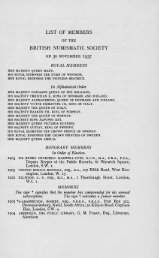

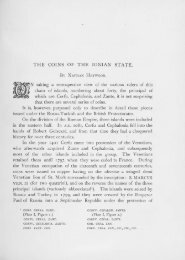
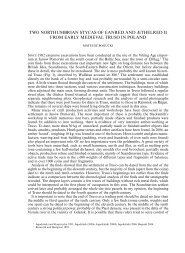

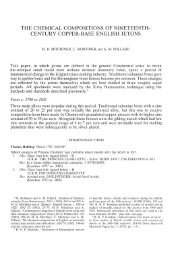
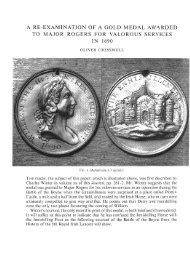
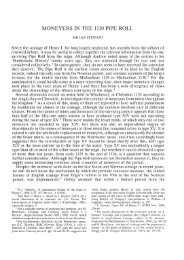
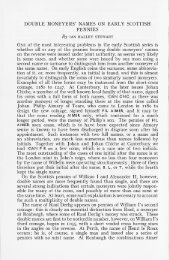
![Two Anglo-Saxon notes: [1] A Cnut die-link between the mints of ...](https://img.yumpu.com/15433998/1/189x260/two-anglo-saxon-notes-1-a-cnut-die-link-between-the-mints-of-.jpg?quality=85)
